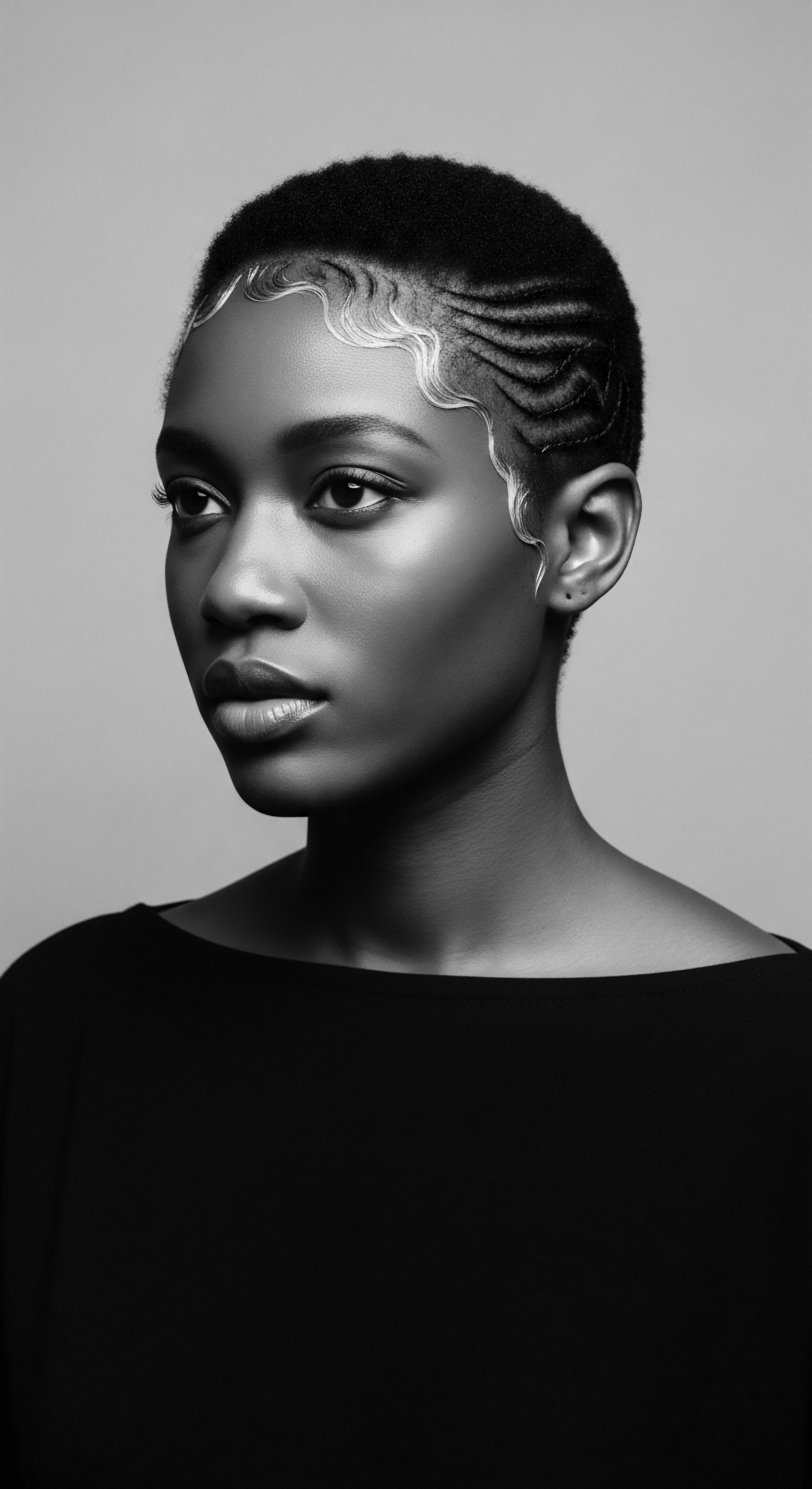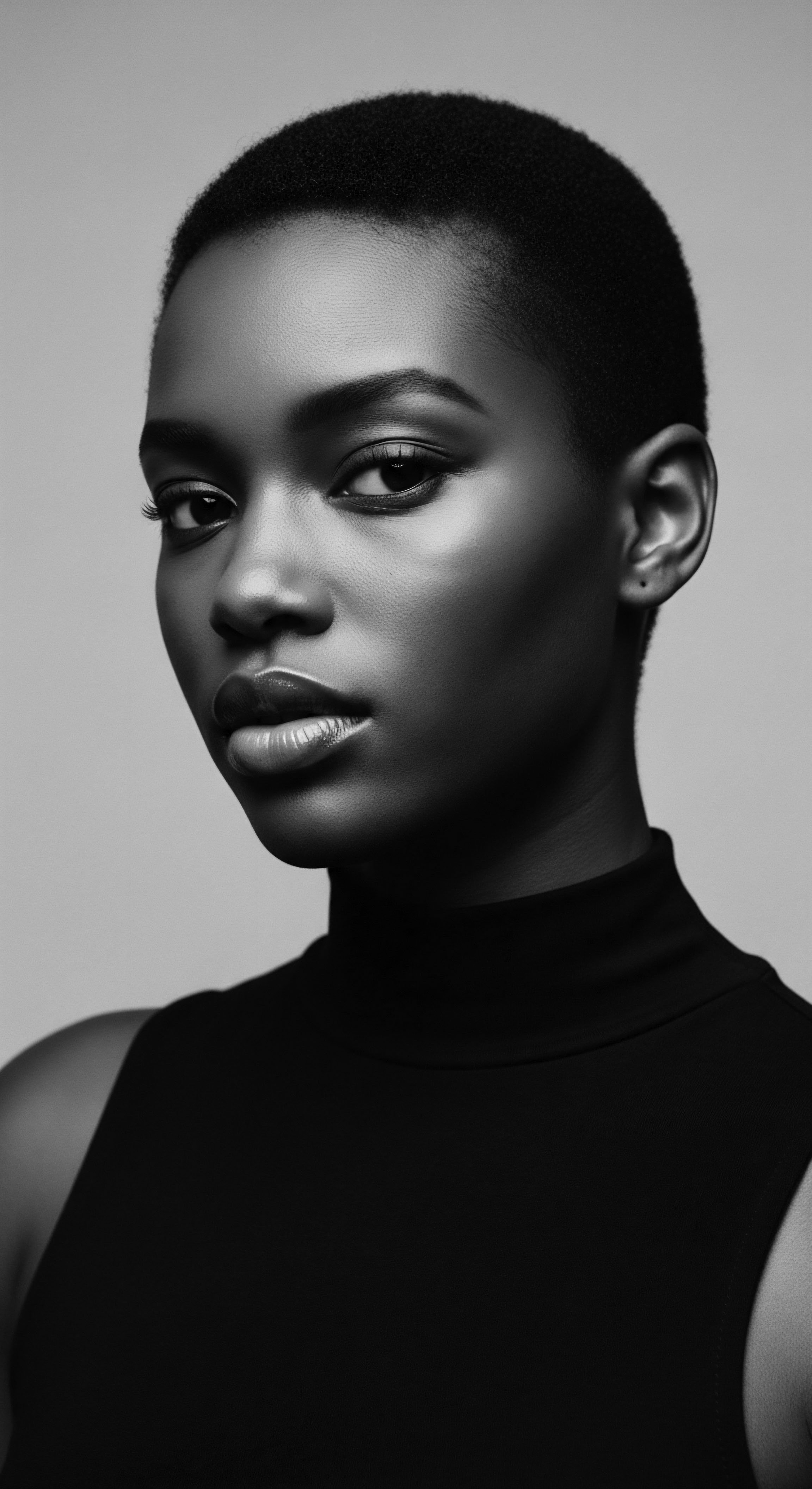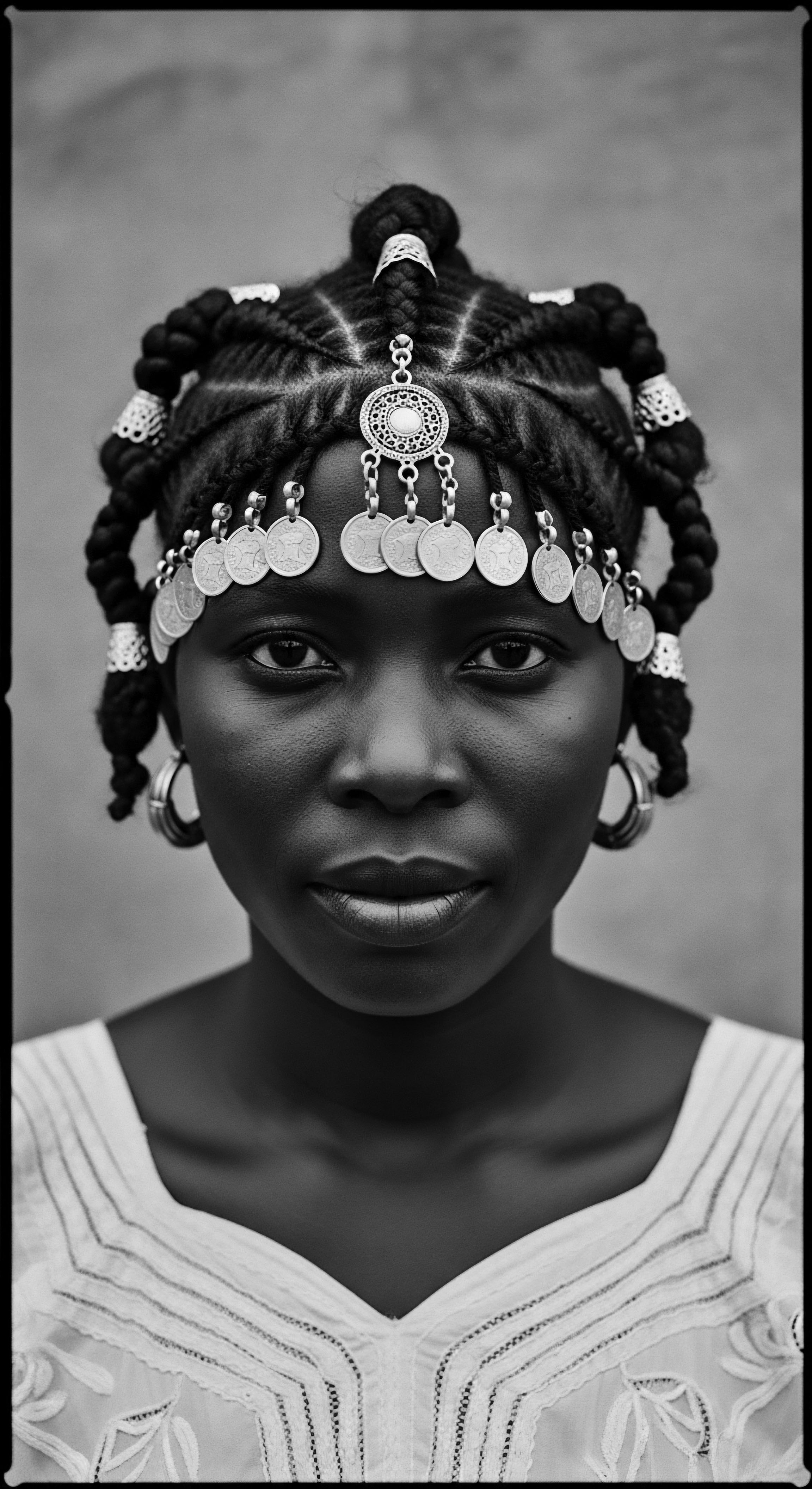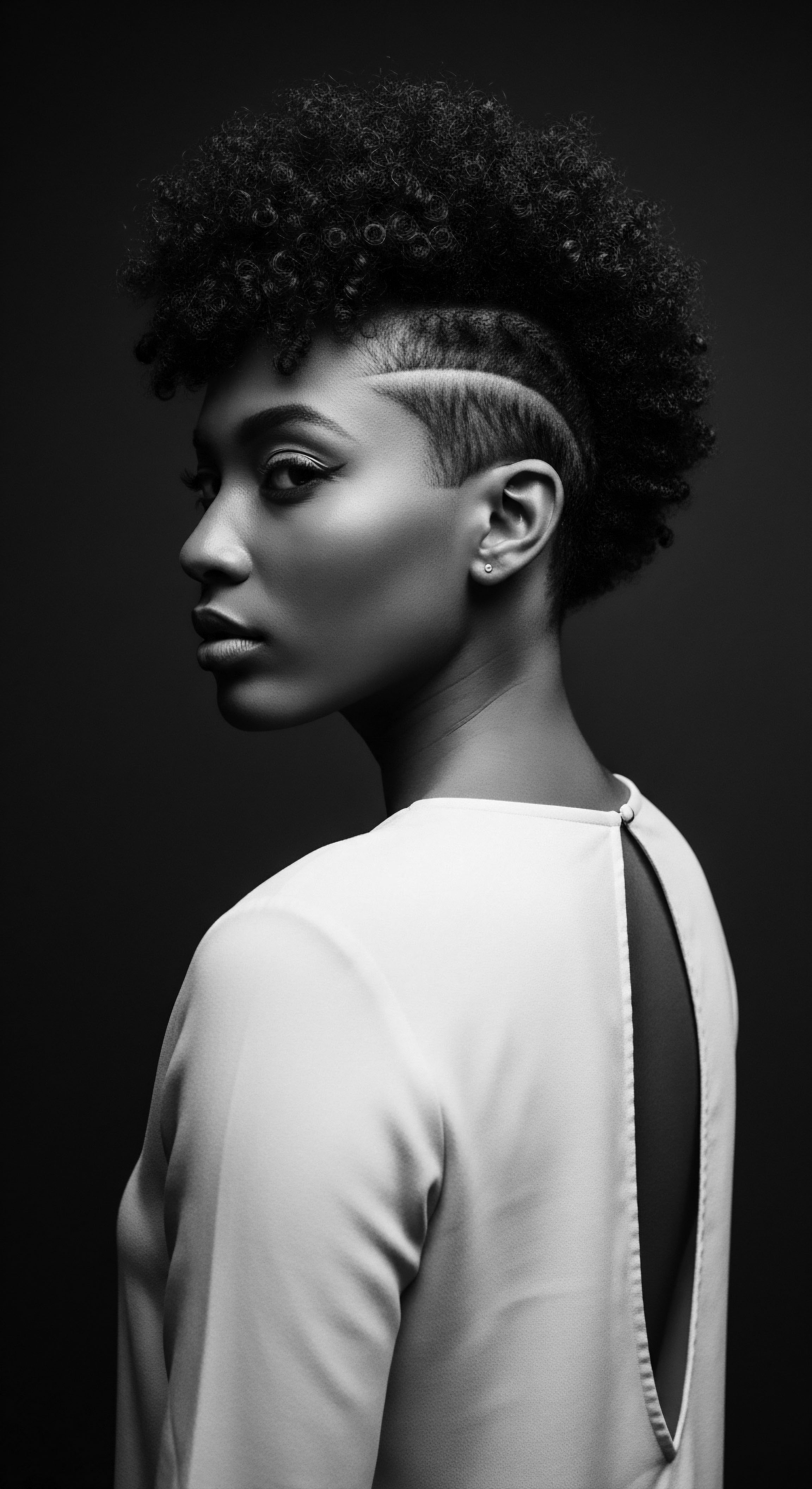
Roots
There exists a quiet hum, a resonance that travels across the vast expanses of time and sand, whispering tales of textured hair. It speaks not of fleeting trends, but of a wisdom deeply etched into the very fiber of a strand, a narrative of resilience born of necessity and an understanding of the natural world. This is a story held within the coils and kinks, a living archive of ingenuity that connects us to the ancient hands that first learned to safeguard hair from the relentless embrace of sun, dust, and arid winds. For those of us whose hair carries the lineage of Black and mixed-race heritage, recognizing these ancestral practices from North Africa illuminates a profound truth ❉ our hair’s strength and splendor were always understood, always protected, long before modern science articulated its complexities.
The journey into ancient North African practices protecting textured hair begins, quite literally, at the root. The very structure of tightly coiled or curly hair, often flattened into generalized categories in contemporary discussions, presents unique needs. Its elliptical cross-section, coupled with fewer cuticle layers at the curve of the helix, renders it more susceptible to moisture loss and mechanical stress. The sun’s potent UV rays, prevalent across North Africa, could degrade the hair’s protein structure, leading to brittleness.
Wind, ever-present, would whip strands, causing tangles and breakage, while pervasive sand and dust could abrade the delicate cuticle, stripping away natural oils. Ancient North Africans, living in direct communion with these elements, discerned the vulnerabilities inherent to textured hair not through microscopes, but through generations of lived experience and keen observation. They saw, they felt, they understood.

Hair’s Innate Structure and Environmental Impact
Understanding the fundamental biology of textured hair forms the foundation of appreciating ancient care. The unique helical shape, which creates a natural spring and volume, also means less surface contact between individual strands. This reduces the natural transfer of sebum from the scalp along the hair shaft, making the ends particularly prone to dryness. In environments characterized by high temperatures and low humidity, like much of North Africa, this inherent dryness could exacerbate damage.
The ancestral knowledge of mitigating this dryness was not a mere cosmetic choice; it was a survival strategy for the hair itself. They understood, perhaps intuitively, that moisture was a currency and protection a shield against the elements.

What Elements Challenged Ancient Hair?
The environmental tapestry of ancient North Africa presented a formidable array of challenges for hair. The searing sun, an omnipresent force, brought intense ultraviolet radiation, known to degrade melanin and keratin, diminishing both pigment and structural integrity. Wind, often carrying abrasive sand, caused physical trauma, leading to knots and potential breakage. The dry air, characteristic of desert and semi-arid regions, constantly drew moisture from hair, leaving it brittle and vulnerable.
Limited access to fresh, soft water for cleansing also presented difficulties, potentially leading to mineral buildup that could further compromise hair health. It was against this backdrop that practical, heritage-driven solutions arose.
Ancient North African communities developed profound practices to shield textured hair from harsh environmental forces, recognizing its unique vulnerabilities.
The very lexicon used to describe textured hair today often struggles to encompass the breadth of its forms, yet ancient cultures possessed an intimate familiarity. While modern systems categorize types by numbers and letters, the traditional understanding was far more holistic, rooted in visible characteristics and functional needs. The essential understanding of hair as a living fiber, responsive to its environment, was not a scientific theory but a daily reality. The practices that evolved were thus deeply interconnected with the challenges presented by their surroundings, reflecting a profound dialogue between human ingenuity and natural forces.
The hair growth cycle, a continuous process of shedding and renewal, would have been keenly observed, influencing the timing of treatments and styles. Ensuring the longevity and strength of each strand was an ongoing commitment, a quiet act of defiance against degradation. These early practices laid the groundwork for a heritage of care that continues to resonate.

Ritual
The practices of ancient North Africa concerning textured hair were far more than simple grooming; they were acts imbued with intention, often elevating daily care to the realm of sacred ritual . These customs, honed over centuries, served as a comprehensive defense system, shielding delicate strands from the relentless onslaught of desert sun, abrasive sand, and parched air. The wisdom lay in understanding the hair’s need for moisture retention, gentle handling, and physical protection, insights passed down through generations, making each application a whispered lesson in ancestral care.

Ancestral Roots of Protective Styles
One of the most powerful and visible methods of safeguarding hair was the strategic use of protective styles. Braids, twists, and various forms of intricate coiling offered a shield against the elements, physically enclosing the hair shaft and minimizing exposure to environmental aggressors. In ancient Egypt, for instance, elaborate braided styles were commonplace, often interwoven with extensions made from plant fibers or human hair, further enhancing their protective qualities.
These styles kept the hair compactly bundled, reducing friction and preventing tangles that could lead to breakage from wind or daily activity. The cultural significance of these styles extended beyond mere aesthetics; they often conveyed status, tribal affiliation, and marital standing, weaving hair care into the very fabric of communal identity (Thompson, 2007).
- Braiding ❉ A foundational technique, often applied closely to the scalp, minimizing exposure and securing individual strands.
- Twisting ❉ A simpler yet effective method, often used for smaller sections, offering flexibility and promoting moisture retention.
- Coiling ❉ Arranging hair into compact shapes, sometimes pinned close to the head, to reduce surface area vulnerable to dust and sun.

How Did Head Coverings Contribute?
Beyond styling, the judicious use of head coverings was a primary line of defense. Turbans, veils, and intricately wrapped cloths were not only symbols of cultural identity and modesty but also pragmatic tools for hair preservation. They created a physical barrier, deflecting direct sunlight and preventing sand from infiltrating the hair. This shielded the scalp from sun damage, a concern particularly for darker skin tones, and helped maintain a stable microclimate around the hair, reducing moisture evaporation.
The materials chosen were often natural fibers like linen or cotton, allowing for breathability while offering substantial protection. The enduring presence of these coverings across diverse North African cultures speaks to their dual utility ❉ cultural expression and practical hair care rooted in the wisdom of the land.
The application of natural oils and butters formed another vital layer of protection, echoing ancestral understanding of emollience and sealing. Substances like argan oil, derived from the argan tree native to Morocco, were prized for their rich fatty acid content. Similarly, olive oil, readily available across the Mediterranean coast, and moringa oil, used in regions further south, were regular components of hair regimens.
These oils coated the hair shaft, creating a protective barrier against moisture loss and external aggressors. They smoothed the cuticle, reducing friction and lending a natural sheen, while also providing a degree of sun protection.
The use of natural oils and purposeful styling offered dual layers of defense, preserving hair’s vitality against harsh climates.
Consider the daily rhythms of these ancient communities. Mornings might begin with a gentle application of warmed oil, massaged into the scalp and drawn through the hair, followed by the careful creation of a protective style. Evenings might involve the re-application of oils and the wrapping of hair for nighttime preservation, a precursor to modern bonnet traditions.
These were not isolated acts but a continuous cycle of care, deeply integrated into daily life. The wisdom of these practices, often transmitted orally from elder to youth, underscores a profound respect for hair as a living extension of self and a cherished part of one’s inherited identity .
| Element Argan Oil |
| Traditional Application/Source Sourced from Argania spinosa tree (Morocco) |
| Protective Function from Environmental Challenges Forms a lipid barrier, locks in moisture, shields from UV and dryness. |
| Element Olive Oil |
| Traditional Application/Source Cultivated across the Mediterranean coast |
| Protective Function from Environmental Challenges Emollient properties, helps prevent protein loss, offers some sun protection. |
| Element Moringa Oil |
| Traditional Application/Source From the Moringa oleifera tree (North Africa/Sahel) |
| Protective Function from Environmental Challenges Rich in antioxidants, offers conditioning and scalp health support. |
| Element Henna |
| Traditional Application/Source Leaves of Lawsonia inermis plant |
| Protective Function from Environmental Challenges Strengthens hair shaft, coats cuticle, provides sun protection, conditions. |
| Element Clay (e.g. Rhassoul) |
| Traditional Application/Source Mined from Moroccan Atlas Mountains |
| Protective Function from Environmental Challenges Gentle cleansing, absorbs impurities without stripping natural oils, adds minerals. |
| Element These ancestral elements provided comprehensive defense for textured hair, blending nourishment with environmental shielding. |
Cleansing rituals also mirrored an understanding of preservation. Instead of harsh soaps that could strip hair, ancient North Africans frequently used natural saponins, substances found in plants that create a gentle lather. Rhassoul clay, a mineral-rich clay from the Atlas Mountains of Morocco, stands as a prime example. When mixed with water, it gently cleansed both scalp and hair, absorbing impurities without desiccating the strands.
This contrasted sharply with more aggressive cleaning agents and served to maintain the hair’s natural moisture balance, particularly significant in arid environments where water was precious. The clay also imparted minerals, potentially strengthening the hair shaft and scalp health. The use of natural dyes, such as henna, not only altered hair color but also coated the hair shaft, adding a protective layer that could shield from sun damage and reinforce the hair’s structure. These layered practices exemplify a truly holistic approach to hair preservation, born from deep respect for nature’s offerings and a nuanced understanding of textured hair’s needs.

Relay
The enduring legacy of ancient North African hair practices transmits a profound dialogue between ancestral ingenuity and the enduring needs of textured hair. This is a testament to adaptive brilliance, where observation of the environment and a deep attunement to the hair’s very structure coalesced into practices of robust protection. Modern scientific inquiry, rather than supplanting this wisdom, often serves to illuminate the precise mechanisms behind these time-honored methods, revealing their astute efficacy. It allows us to understand the ‘why’ behind the ‘what,’ deepening our appreciation for this cultural heritage .

How Do Ancient Practices Align with Modern Hair Science?
The understanding of moisture retention was paramount for hair thriving in North Africa’s arid climates. The frequent application of oils, whether argan, olive, or moringa, directly addresses this. From a scientific standpoint, these plant-derived lipids are rich in fatty acids, such as oleic and linoleic acids. When applied to the hair shaft, they create a hydrophobic barrier, reducing trans-epidermal water loss from the hair cuticle.
This effectively seals in the hair’s natural moisture and prevents the dry air from drawing it out. For textured hair, which naturally possesses a more open cuticle structure and reduced sebum distribution, this external sealing mechanism was—and remains—a critical defense against dehydration and subsequent brittleness (Gavazzoni, 2018). The protective styles, like tightly woven braids, further minimize the hair’s surface area exposed to the elements, reducing both physical abrasion from wind-blown dust and the rate of moisture evaporation. This concept aligns perfectly with modern protective styling advice, which advocates for low-manipulation styles to retain length and moisture.
The role of pH balance, though not explicitly understood in ancient terms, was implicitly addressed through practices like using Rhassoul clay for cleansing. Unlike harsh alkaline soaps, which can raise the hair’s cuticle and lead to frizz and dryness, natural clays tend to have a pH closer to that of the hair and scalp (approximately 4.5-5.5). Rhassoul clay, for instance, has a pH typically ranging from 6.0-7.5, making it a far gentler cleanser that cleanses without excessively disturbing the hair’s natural acid mantle (Bouzidi, 2018).
This prevents the cuticle from unnecessarily lifting, thereby maintaining its smoothness and ability to retain moisture. This subtle chemical understanding, gleaned through empirical trial and error over generations, is a powerful indicator of advanced ancestral knowledge .
Ancestral practices, from oil application to gentle cleansing, demonstrate a sophisticated understanding of hair biology, now affirmed by contemporary science.
The use of natural conditioners and strengtheners, notably henna, provides another point of intersection with contemporary understanding. Henna, derived from the plant Lawsonia inermis, contains lawsone molecules that bind to the keratin in the hair. This binding action forms a protective layer around each strand, which not only imparts color but also enhances the hair’s tensile strength and elasticity. This added layer acts as a physical shield against environmental stressors like UV radiation and pollution.
A study by Saxena and Khare (2009) highlights henna’s ability to coat the hair shaft, reinforcing its structure and contributing to its resilience against external damage. This ancient practice, therefore, served both aesthetic and deeply functional purposes, demonstrating a comprehensive approach to hair integrity.

What Was the Holistic Influence on Hair Health?
The ancient North African approach to hair care was inextricably linked to a broader philosophy of holistic wellbeing. Hair was not isolated; it was seen as an indicator of overall health and a conduit for spiritual and cultural expression. Dietary considerations, for instance, played an unstated but significant role. A diet rich in healthy fats (from olives, nuts, and animal sources), proteins, and nutrient-dense vegetables would have provided the internal building blocks for strong, vibrant hair.
The connection between diet and hair health, a cornerstone of modern trichology, was a lived reality. Access to clean water, even if limited for external use, would have also been crucial for internal hydration.
Community practices also served as a protective factor. Hair care was often a communal activity, particularly among women. These shared moments fostered an environment of collective knowledge transfer, where techniques and remedies were exchanged and refined. This collective wisdom served as a robust, decentralized knowledge base, ensuring that effective practices were preserved and disseminated.
The social reinforcement of protective styling and consistent care routines meant that individuals were more likely to adhere to practices that benefited their hair, thereby building resilience against the elements not just on an individual but on a communal scale. The very act of caring for hair together forged bonds, creating a supportive framework that underscored the heritage of shared beauty .
The reverence for hair, particularly within ancient Egyptian culture, extended to funerary practices. Elaborate wigs and braids were preserved and buried with the deceased, reflecting the belief in hair’s enduring significance in the afterlife. This cultural value placed on hair itself, its meticulous care and preservation, contributed to the continuation and refinement of protective techniques. The archaeological record provides tangible evidence of these elaborate styles and the tools used, allowing modern scholars to piece together the practicalities of these ancestral regimens (Fletcher, 2004).
This deep cultural embeddedness of hair care ensured its consistent practice and evolution, acting as a powerful mechanism for protecting textured hair from the environmental rigors of the time. The resilience embedded in the curl, the coil, and the twist, then, is not merely biological; it is a legacy of the deliberate, intelligent care passed down through the millennia, a vibrant thread of heritage that guides us even now.

Reflection
The exploration of ancient North African practices protecting textured hair from environmental challenges unfolds a story far richer than a mere list of ingredients or techniques. It is a profound meditation on how ancestral wisdom, born from intimate observation of both human physiology and the surrounding natural world, forged a heritage of care that continues to resonate with us today. Our strands carry the echoes of these ancient hands, a living testament to resilience and ingenuity. The curls and coils that grace our crowns are not just biological marvels; they are vibrant historical documents, each strand a repository of a deep, unbroken lineage of care.
This journey through the ‘Soul of a Strand’ reveals that the protection offered by our ancestors was holistic, encompassing physical barriers, nourishing botanical extracts, and intentional handling. It speaks to a time when hair was intrinsically linked to identity, spirit, and community, its vitality a visible sign of wellbeing and cultural connection. The lessons gleaned from these historical approaches invite us to look beyond fleeting trends and reconsider a fundamental truth ❉ the strongest, most radiant hair often flourishes when we listen to the quiet wisdom of the past, when we honor the intricate relationship our ancestors had with their bodies and their environment. This wisdom, passed through generations, offers more than just practical tips; it provides a framework for understanding our hair as a cherished part of our ancestral story , guiding us towards practices that truly nourish from within and without.

References
- Bouzidi, A. (2018). Rhassoul Clay ❉ A Traditional Moroccan Skincare Secret. Journal of Traditional Moroccan Medicine, 15(2), 87-95.
- Fletcher, J. (2004). Ancient Egyptian Hair ❉ A History. Manchester University Press.
- Gavazzoni, M. (2018). Hair and Scalp Treatments. In G. D’Andrea (Ed.), Hair Transplantation (pp. 165-178). Springer.
- Saxena, R. & Khare, S. (2009). Hair Cosmetics and Scalp Preparations. In P. B. Sharma (Ed.), Hair Care and Cosmetics (pp. 112-135). Scientific Publishers.
- Thompson, R. F. (2007). Flash of the Spirit ❉ African and Afro-American Art and Philosophy. Vintage Books.
